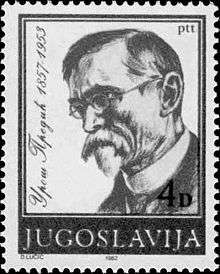Uroš Predić

Uroš Predić (Serbian Cyrillic: Урош Предић, pronounced [ûrɔʃ prɛ̌ːdit͡ɕ]; Orlovat, 7 December 1857 – Belgrade, 12 February 1953) was a Serbian Realist painter, along with Paja Jovanović and Đorđe Krstić. Predić is perhaps best known for his early works used ordinary peoples, as well as his many portraits.
Biography


He was born in Orlovat, and attended primary school in Crepaja. After finishing his gymnasium in Pančevo (this school was later named after him), he went to Vienna to study on academy in 1876. He graduated from the Academy of Fine Arts of Vienna in 1880. He studied in the class of professor Christian Griepenkerl, who also taught Predić's contemporary Paja Jovanović. During his studies, he received the Gundel's prize – for a male model painting in oil. In 1882, he worked in private studio of professor Grieppenkerl, and in the period from 1883 to 1885 he was an assistant professor of the Department of Antiquity at the Art academy in Vienna. During that time, under the instruction of professor Grieppenkerl, and the renowned architect Theophil Freiherr von Hansen, he painted 13 wall paintings of ancient, historical and mythological compositions for the frieze in the House of Lords at Reichsratsgebäude (Imperial Council Building) in Vienna.
In 1885, he returned to Orlovat, where he painted a series of paintings about the life of his fellow villagers. After that, in period from 1886 to 1889, he lived in Belgrade, and in period from 1890 to 1893 in Novi Sad and Stari Bečej. From 1894 to 1909, Predić lived in Orlovat, and from 1909, until his death, he lived and worked in Belgrade. First exhibition of his paintings was in 1888 in Belgrade. He was elected to the group of painters who are represent Serbia at the 1889 Exposition Universelle in Paris. In a small gallery he was presented the 8 oil paintings. Although the French criticism did not recognize his work Predić will become very popular in the impoverished Serbia. Especially because of his sense of humor present in some works. He had many exhibitions, both in Serbia and aboard. Later, portraits and icons prevail in his opus.
He was one of the founders of the "Lada" society in 1904, and became its president. He was elected as associate member of the Serbian Royal Academy on 26 January 1909, and on 3 February 1910 as a regular member. He was one of the founders of the Society of painters in Belgrade in 1919, and was its first president. Uroš Predić painted the icons for the Bečej orthodox church, and the icons for the chapel of Bogdan Dunđerski. He died in 1953 in Belgrade, at the age of 95. He was buried in Orlovat.
Works
Some of his famous works include Merry brothers, Orphan (on mother's grave), the historical painting Bosnia-Herzegovinian fugitives and perhaps his most recognizable Kosovo Maiden. Predić also painted the famous portraits of the presidents of Serbian academy: Sima Lozanić, Stojan Novaković (1920), Jovan Žujović (1921), Jovan Cvijić (1923), Slobodan Jovanović (1930), Bogdan Gavrilović (1935) Aleksandar Belić (1940). He also painted portraits of Michael I. Pupin, Laza Kostić, Mihailo Petrović Alas (1943), Ksenija Atanasijević (1917), Branislav Petronijević (1911) amongst others.
Gallery
 Copy of Going to be trouble (1886) published in Nova iskra (1899); the original has never been recovered
Copy of Going to be trouble (1886) published in Nova iskra (1899); the original has never been recovered Happy Brothers (1887)
Happy Brothers (1887) Orphan on mother's grave (1888)
Orphan on mother's grave (1888) Kosovo Maiden (1919)
Kosovo Maiden (1919)
See also
External links
| Wikimedia Commons has media related to Uroš Predić. |